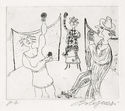
19th, 20th & 21st Century Fine Prints
707-546-7352 · fax 707-546-7924 · web: www.annexgalleries.com · email: artannex@aol.com
Ferruccio Bolognesi Biography
Ferruccio Bolognesi
Italian
1924–2001
Biography
Ferruccio Bolognesi, painter, printmaker, sculptor, and set designer, was born in Mantova, Italy on February 21, 1924. He was a teenager when he took part in the partisan struggles, using theater, music, and art as expressive outlets. In the 1950s he took up painting and printmaking, even as his job as an accountant took up most of the daylight hours. His work, inspired by the circus and other theatrical entertainments of his youth, and exhibiting a strong naïve surrealism, gained a following by 1960 when he held his first show of paintings in Brampton at the Suzzara Gallery, where he also won his first prize, the XIII Suzzarra Prize. He further studied printmaking with Carlo Bertonlini and at a workshop in Venice.
By the 1970s he had incorporated mural and sculpture into his oeuvre, and he began to exhibit more widely, traveling to Paris, Milan, Croatia, Wasaw, and London, to critical acclaim. His tempera painting "The Funeral in Sicily" won the Luzzara prize in 1975 and was permanently installed at the Cesare Zavattini museum. It wasn't long, however, until he became dissatisfied with the mediums he was familiar with. Realizing he wanted to incorporate music into his work, he began to collaborate with musicologist Claudio Gallico, recreating classic melodramas with elaborate set and costume designs. His first collaboration with Gallico was Paisiello's "Nina pazza per amore". In the face of declining interest in classic music, the performance was a success, for which Gallico wrote: "Bolognesi's vision seemed convenient to interpret the naive sentimentality of the declining eighteenth-century theater and melodrama, that theater of good feelings…"
The opera resulted in the founding of the theater workshop of Sabbioneta, for the staging of melodramas: "Dafne" by Marco da Gagliano, "Aeneis" by Domenico Mazzocchi, "The Fight of Tancredi and Clorinda", "Il ballo delle Ingrate and Tirsi" and "Clori" by Claudio Monteverdi. The success of "Dafne" led to its performance at the Victoria and Albert Museum in London for the Princes of Wales in 1981. For this work the tireless Bolognesi designed the dinner menu, the staging, and collaborated with renowned film and stage tailor Tirelli of Rome for the costumes. The Sabbioneta workshop became Bolognesi's main focus well into the 1980s, when he returned to sculpture. Taking commissions for public and commercial works, he created installations for both interiors and exteriors, made from iron, copper, wood, and recycled materials such as plastic and cardboard. His large, fantastical pieces are included in the collections of the corporation Lubiam (Mantova, IT), the city of Novellara (IT), the Garden of Palazzo Soardi (Mantua, IT), the Castelgoffredo Town Hall art collection (IT), the Conservatory of Music Campiani (Mantua, IT), and the Bottega d'Arte Bolognesi collection, dedicated to the artist himself.
Bolognesi died in Mantovia, Italy on January 16 of 2001.


